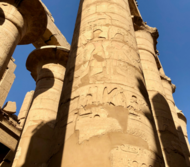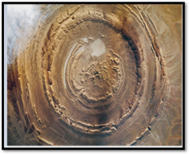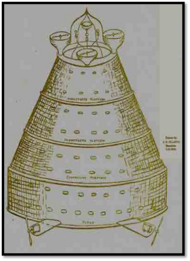Chapter 3:..
The (re)start of civilization

The various early civilizations from around the world all seemingly started at around the same time, ie: 3000 to 4000 BCE. At least that is according to the archaeological record (since I have no formal training in that field, I could be wrong). There are several things that lead me to suspect that the early civilizations (Egypt, Sumeria, Indus valley etc), are actually a resurrection of civilization. If my speculation that the underground cities in Turkey were built for the preservation of people in the distant past is correct, then it is possible that several generations might have passed before people could again live above ground level. By the time people emerged from underground living, the knowledge about Gobekli Tepe, for instance, had been lost.
Mayans start their 4th world calendar from 3114 BCE, which, more or less, coincides with the start of other civilizations in Egypt and Mesopotamia, I am uncertain about when the civilizations of Indus valley and China began, but it would seem that they started out at much the same time. When they emerged to the surface again, they continued to use the calendars they had previously used, but soon found it necessary to add 5 extra days, since the world was now spinning slightly faster. This also helps to explain why there are so many stone circles around the world, people found that the calendar they had previously used was incorrect, so they were desperately seeking a means of correction. To do this they needed a means of recording astronomical sightings, hence the stone circles.
I don’t profess to be an expert in archaeology, but I cannot help but notice the massive gap in the archaeological record between Gobleki Tepe and similar sites, which date from around 9000 BCE or earlier, and other civilizations starting at around 4000 BCE. What happened during this time? I would speculate that it was a time of severe hardship and survival was very difficult. I am, of course aware of the ideas of Graeme Hancock, and I have read some of his work. I have also watched the Netflix series based on his work, and whilst I agree with much of what he says, the ideas expressed in this article were arrived at independently, the biggest influence on my thinking has actually been Erich von Daniken. I don’t agree with many of his ideas, but he did provoke my curiosity and, I suspect, that of Hancock. There are, of course many other writers who have influenced my thoughts over the years.
An Ancient area that we know a lot about is Egypt. Because it is concentrated around the Nile river most of its historical sites are in a narrow strip along the Nile river, this made it much easier for researchers to find ancient buildings and necropolises, consequently we have more information about ancient Egypt than almost any other ancient site on the planet. However, anything before about 3100 BCE is very vague.
I have been reading as much as I could about ancient Egypt for as long as I can remember, especially about the Giza pyramids. There are certain things which lead me to doubt the “official” narrative around the Giza pyramids. To summarise, the official narrative states that each of the pyramids was simply a burial mound for a pharaoh, to whit; Khufu, Khafre and Menkaure. Each pyramid has a “valley temple” (a massive building), a connecting “causeway” (also a substantial structure) and a “mortuary temple” (another massive building).
In the case of the “great” pyramid, the pyramid itself has been estimated to contain about 6 million tons of cut stone blocks, if you add the valley and mortuary temples and the causeway, the total of cut stone will probably be close to 8 million tons, all of which is simply for the burial of a king, who reigned for less than 30 years. If you consider that much of the stone was Aswan granite averaging around 40 tons per block, with some of it polished to a mirror like finish, I cannot avoid being very sceptical. There are several other features which do not fit the narrative we are expected to believe. For me, an important one being the triple “portcullis” doors in the access tunnel to the “Kings” chamber.
These doors are supposed to have been to prevent “robbers” from pillaging the Kings grave goods. It would seem that these doors apparently had a pulley system to control them in ancient times, they were about 300mm thick. It seems to me that considering the 3 massive granite plugs blocking the ascending passage, the portcullis doors could not have served as a deterrent to grave robbers, any robber that could get past the massive granite plugs, would have little difficulty with 300 mm portcullis doors. There are a number of other features which also do not fit the “tomb” narrative, but that already mentioned is enough to cast serious doubt on the “tomb” theory.
Other aspects of ancient Egypt also do not fit with the textbook narrative, one being the age of the pyramids at Giza, as well as the sphinx. We are told that the great pyramid was built by Khufu, Egyptologists will not deviate even one iota from this theory, yet the evidence to support this is actually quite flimsy. The best evidence they have, which is even possibly contemporaneous with the time of Khufu, is a document known as “Merer’s diary”. This diary mentions Khufu’s “project”, it makes no mention of pyramid or tomb at all. Apparently it refers to the transport of blocks of Tura limestone to Giza for Khufu’s project.
I suspect that Khufu may have been carrying out repairs to the pyramid, and this is what Merer was involved in. All other evidence is from a much later period and cannot be regarded as solid evidence. There is also carbon dating of mortar from certain areas of the pyramid, but I don’t see any mortar in any of the pictures or videos I have studied. I suspect therefore that the mortar is from areas that have been repaired at a later date and that the pyramid was originally built without mortar. Merer could have been involved in the repair of the pyramid.
I have some alternative ideas, for which I also do not have solid evidence, but I think they might be worth considering. To begin with, the complete lack of any inscriptions within the pyramid, or at any other location strikes me as being very strange. Bear in mind that the great pyramid would have been a massive achievement for Khufu as king, and he would definitely want the entire world to know of his great achievement, yet there are no inscriptions anywhere pronouncing the great pride Khufu would have felt for the building of this massive pyramid.
In addition, there are no illustrations from anywhere around the old kingdom showing any pyramids at all (at least none I could find). The earliest portrayal of a pyramid I could find dates from about 1100 years after the time of Khufu, it is almost as if the pyramids were a “taboo” subject before that. There are early depictions of pyramids, the earliest being an ostrich egg dating from around 7000 BCE, which seems to portray pyramids. In addition to that, there exists pottery from the Naqada 2 period which also appears to portray pyramids, or it could be just triangular patterns. Some of these portrayals appear to be shaded in such a way as to lend credence to the idea that they might depict pyramids. Specifically, they seem to show a line of 4 pyramids, 2 large and 2 smaller.
This seemed very strange, since I was not aware of any group of 4 pyramids in Egypt. I later came across reports from the 16th and 17th century which state that there were 4 pyramids at Giza 2 large and 2 small, with the westernmost being built of black stone.
Today there exist only 3 pyramids at Giza (excluding the small planetary pyramids). I have read of speculation that the “wall of the crow” is actually what remains of the “black” pyramids causeway. I do not pretend to have any evidence to support this idea other than that already mentioned. There does exist some additional evidence which could support the grouping of 4 pyramids.
That evidence is to be found in some of the ivory tags or labels found in a tomb dating from about 3100BCE at Abydos, the tomb is known as “tomb U-j”.
Ivory tag tomb U-j
Some of these labels depict a line of 4 triangles which are shaded in such a way as to indicate they represent pyramids; they also have an illustration of an egret. These tags are thought to be the earliest form of writing in ancient Egypt and are thought to indicate a particular place name. This is obviously not cast iron evidence, but it does seem to indicate that the Giza pyramids may have existed before 3100 BCE, which would explain why there is no hieroglyphic writing inside, the writing system did not yet exist. The sphinx dating is also currently contentious, with some dating it to more than 10,000 years ago. Whilst most of the above concerns mainly the “great pyramid”, it could also apply to the other Giza pyramids. If my speculation is correct, it would mean that the Giza pyramids are possibly the oldest in Egypt.
There are several other issues about ancient Egypt which tend to make me uneasy about the currently accepted timeline for various aspects. Firstly, I must stress that I have never been there and I base my misgivings on observation of the photographic and video evidence of others. The most notable problem I see with the dating of structures and attributing them to a particular pharaoh or even dynasty, is the apparent use of a sort of plaster coating on many walls and columns, the inscriptions on these items is in the plaster and not on the walls or columns.
Any pharaoh could then have recovered a wall or column in plaster and add his own name, apparently this has happened many times. Also items which had been devoid of any markings could also have been marked with a pharaohs name, thus allowing said pharaoh to claim the item as his own, for example, there are many statues which are supposed to be of Rameses, what if he merely found these statues and had them inscribed with his name? The same problem applies to the serapeum at Saqqara.
Columns at Karnak with flaky plaster
Furthermore, I find it strange that a culture with extremely lifelike statues, has paintings which seem almost childlike in comparison, I would expect their paintings to also be lifelike, it is almost as though there were different cultures involved with the art works. The sculptures of ancient Egypt are comparable to that Michelangelo for instance, their paintings however, are not in the same class.
Another strange thing which could possibly affect the dating of the quarry at Aswan. In a video by Ben van Kerkwyk, on the you-tube channel “Uncharted X”, I noticed that in a section that had supposedly been quarried at Aswan, there were rock paintings that appear to be from the “Naqada2” period. If that is correct, it would imply that the quarry at Aswan (granite) was active perhaps before the Naqada2 period.
This would make the quarry active before about 3500 BCE. Other sneaking suspicions I have, concern the volume of water, and the water level at the time the pyramids were built. Never having been in the area, I am operating on pure supposition and guesswork in this regard, but I have noticed that different structures seem to be built on different levels around the Nile. Looking at where the inlets at the Khafre “valley” temple are positioned (I am assuming they are water inlets), it would seem to me that they are considerably above the current water level of the Nile, they are also above the level of some other structures on the banks of the Nile (I could be completely wrong).
This suggests to me that the Nile was much wider and deeper at the time the Giza pyramids were built, it would also mean that the area that Cairo currently occupies would have been completely under water, at that time.
It is perhaps fitting to discuss Atlantis immediately after Egypt, since they are closely related. The story of Atlantis comes to us via the writings of Plato, one problem we have is that Plato did not profess to be writing history, he was writing fiction. This means that the entire story could simply be a figment of his imagination. Unfortunately, it is not that simple.
The reference Plato gives as his source is Solon, who was a person who did exist. Solon apparently got the story from a priest at the temple in Sais, which also actually existed. Apparently, it is known that Solon did in fact travel to Sais in Egypt, so maybe Plato used the story that had actually originated with Solon, and was not just fiction. The temple at Sais has not existed for some time since Plato’s time, so we cannot check if the story is inscribed on the walls of the temple as Plato says. However, the temple of Horus at Edfu has a very similar story written on its walls, this is surely not just coincidence, so maybe there is some truth to the story of Atlantis.
The story of Osiris, Isis and Horus, is an Egyptian myth that has survived from what the ancient Egyptians called the “Zep Tepi”, which means “the first time” and it refers to a time when the Gods walked the earth. The legend of Osiris has very few written texts about it, and there exists stelae, currently in the Louvre in Paris which details the story and describes many aspects of the legend. Of particular interest to me is the fact that the story seems to take place in a location which is not Egypt.
The translation of the stelae that I have refers to the “land of the 2 shores”, and also mentions Egypt, but in conjunction with the “far off lands”. This does not sound like a description of Egypt being the scene of the myth. Another translation of the same text refers to the “land of the 2 river banks”, which is a very odd way to describe Egypt. The point is that, although we have no proof of the existence of Atlantis, we should not be in too much of a hurry to discard the story. A lot of the history mentioned in Egyptian texts, seems to have occurred somewhere that is not Egypt.
Richat Structure
I would like to briefly address the matter of the [1]Richat structure and the possibility that it could be the site of Atlantis. The name Atlantis comes to us via Plato, and it is possible that Plato chose an existing name from north Africa that had no connection to the “Zep Tepi” of the Egyptians.
So, while the place Plato describes could exist, it is possible that the name Atlantis was a fiction added by Plato.
Jimmy Corsetti of the YouTube channel “Bright Insight”, has been pushing the idea that the site of Atlantis was the “Eye of the Sahara” as the structure is also known. I can understand why some might think so, but I disagree. The main problem I have with the idea is the fact that it is above sea level now, whereas the sea level rise of about 150 meters, at least, is what led to the demise of Atlantis, supposedly during the Younger Dryas event.
This means that whatever the elevation above sea level is now, you need to add at least 150 meters to arrive at the elevation above sea level for the Richat structure during the prime of Atlantis, the figure I arrive at is about 635 meters above sea level. This should rule out the idea of it being the site of Atlantis. I do have some idea for where Atlantis may have been, but that would side-track things a bit.
All of the ancient civilizations whose records we have been able to decipher had complicated religions with many Gods or Lords, not only Lords of the underworld as we have seen. What if all these ancient Lords existed, and where might they have come from? This is a question that has troubled many people for many years, I personally was brought up in a Christian household and I know that it is not easy to put aside religious teachings and look at the world objectively. For this reason, when one criticizes any religion in any way, there is inevitably a backlash. My views will inevitably offend some, and for them I have some sympathy.
The main religions of the world today are the Hindu, Christian, Jewish and Moslem. The most animosity is between the last three, the strange thing is that they all actually have the same origin and worship the same God, the God of Abraham. All of these religions have been influenced by other older religions. The first five books of the “old testament” is basically the same for all 3 these religions, and was supposedly written by Moses. Since the decoding of the Sumerian script, we now know that many of the biblical stories are borrowed from earlier civilizations. What interests me is that the early “Gods” in these stories (including archangels and such), seemed to be real flesh and blood characters, they were capable of fighting arguing and making mistakes like any other person, but they did have special powers and foresight. They were mostly beneficial (to the chosen people), but were at times vindictive and even genocidal, in other words, they were just like average humans.
Normal humans like myself have to wonder about who these Gods actually are and where do they come from? Most people have to give the answer “I don’t know” to this question, and that is the honest non-religious answer for our time. The next question I have is “where are they now”? We can be reasonably certain that they did, or do exist, so what happened to them? That is a mystery I would love to unravel. We should first see what the ancient myths and religions can tell us about the Gods/Lords of old.
The Christian religion, and presumably the Islamic and Jewish as well view God as a creator who created everything, including humans, and his home is heaven, above the clouds. This God is an almighty, all knowing usually benevolent being, and is supposed to be the only God around. At the same time the scriptures refer to other Gods quite frequently, even sometimes “sons of Gods” (Genesis 6).
Also in exodus God says not to worship other Gods because he is a jealous God. There are other indications also that there were more Gods and not only 1 God. It is strange therefore that the Abrahamic religions should insist that there is only 1 God, when their own scripture indicates more than one. The impression I get is that this particular God adopted the descendants of Abraham as his special people and was quite happy to eliminate any other tribe or group that got in the way. He was also not averse to punishing his people for disobedience.
What interests me is that he was in personal contact with his people, and his arrival was often accompanied by lots of noise, smoke and flames. The book of Ezekiel especially gives descriptions of a noisy flying machine, from the description, it was a lot like some of our modern day drones, only much bigger.
Vimana Flying machine
The Hindu sacred writings also mention flying machines and apparently they are quite numerous and differ considerably in size. Since I don’t read Sanskrit I rely on reports from others, however all scholars seem to agree that according these ancient writings, there were many flying machines (called Vimana) in ancient India.
All cultures that I know of seem to have had flying beings in attendance. The art of Sumeria, Egypt, ancient India and others all have flying beings. In Egypt they found what looks like a model glider, years before the Wright brothers ever got off the ground, it is known as the Saqarra bird, but it is clearly not a bird.
Saqarra bird
In a museum in Colombia there are ancient gold miniatures of a number of strange looking devices, among them are several which are clearly delta wing aircraft, these are known as the Quimbaya jets.
Quimbaya jets
I am confident therefore, about saying that these ancient Gods were very similar to humans and had flying machines!
Obviously therefore they were an advanced group of beings, who could travel extensively throughout the world. They also seemed to have an inclination to assist humans. It also seems they were capable of interbreeding with humans, the results of such breeding were disastrous at times, if biblical accounts are to be believed.
So, where could they have come from, were they from elsewhere in the universe? It is perhaps possible that they arrived on Earth from elsewhere, but that actually does not solve the problem for us, it merely moves the problem off planet. It is also possible that they evolved right here on Earth, which is the more likely answer for me. It seems to me, that we can no longer deny the existence of this advanced group, whom our ancestors called Gods.
What happened to the Gods?
Artists impression of UFO
The Gods of the Old Testament flew around in noisy smoke belching machines. Today there are still unknown flying machines buzzing around. Is it possible that these are descendants of our Old Testament Gods whose machines have evolved into more sophisticated “flying saucer” type machines?
It could be that they are still keeping a discreet eye on us. It is undeniable that there are “UFO’s” buzzing around, this comes from many reports by reliable witnesses. We also have the weird phenomenon of crop circles, which seem definitely the creation of intelligent beings. At least some and maybe all of the UFO’s seem to be able to travel under water, so it could be that our Gods of old are still around and their home base could be under the ocean somewhere on our planet. So, has the “lost ancient civilization” been under our noses the whole time. It’s worth considering. The idea that UFO’s come from somewhere else in the cosmos does present certain logistical problems which disappear if we accept that they are based on earth.
References:
https://www.eurokidsindia.com/blog/history-of-human-evolution-stages-timelines-and-facts.php
https://notyouraverageamerican.com/spiral-petroglyphs-guizhaguina-ecuador/
https://www.machutravelperu.com/blog/how-were-the-nazca-lines-made
https://www.pathsofjordan.net/the-dolmens-an-endangered-heritage-in-jordan
https://www.dalysofdonore.com/places-of-interest/newgrange
https://www.ancient-origins.net/ancient-places-europe/carnac-stones-enigma-solved-ancient-science-0010311
https://en.wikipedia.org/wiki/Baalbek_Stones
https://es.wikipedia.org/wiki/Sacsayhuam%C3%A1n
https://christineandreae.com/betrayal/lkosam_boat_544-reed/
https://www.bizsiziz.com/what-is-ancient-sumerian-writing-doing-in-america-deciphering-the-fuente-magna-bowl/
http://ancientlosttreasures.yuku.com/forums/55/Father-Crespi-Collection-Rese
lsmar.com/elsmarqualityforum/media/found-in-ecuador-in-father-crespis-collection-of-mayan-and-aztec-items-http-ancientlosttreasures-yuku-com-forums-55-father-crespi-collection-rese.3216/
https://www.ancient-origins.net/news-mysterious-phenomena/controversial-claim-geologist-mysterious-tracks-turkey-caused-unknown-020489
https://nomadicniko.com/turkey/gobekli-tepe/
https://en.wikipedia.org/wiki/G%C3%B6bekli_Tepe
https://bigthink.com/strange-maps/derinkuyu-underground-city/ https://www.theancientconnection.com/megaliths/china/longyou-caves-china-megalithic/
https://en.wikipedia.org/wiki/Ereshkigal
https://www.tripadvisor.co.za/Attraction_Review-g294202-d317746-Reviews-Pyramids_of_Giza-Giza_Giza_Governorate.html
https://www.reddit.com/r/TombUJ/comments/1fz4cu9/tomb_uj_ivory_tags/#lightbox
https://upload.wikimedia.org/wikipedia/commons/5/52/Great_Hypostyle_Hall%2C_Karnak_Temple%2C_Luxor%2C_LG%2C_EGY_%2848009627157%29.jpg
https://en.wikipedia.org/wiki/Richat_Structure#/media/File:Richat_Structure_ISS030-E-12516.jpg
Sanscrit is an ancient Indo-European language of India, in which the Hindu scriptures and classical Indian epic poems are written and from which many northern Indian (Indic) languages are derived.
https://www.hinduwebsite.com/sacredscripts/hinduism/vimana/plates.asp
https://www.ancient-origins.net/ancient-technology/controversial-saqqara-bird-00386
https://en.wikipedia.org/wiki/Quimbaya_artifacts#/media/File:Precolombina_cultura_prc.jpg
https://www.smithsonianmag.com/smithsonian-institution/earth-vs-the-flying-saucers-the-hirshhorn-23999283/
Leave a comment










